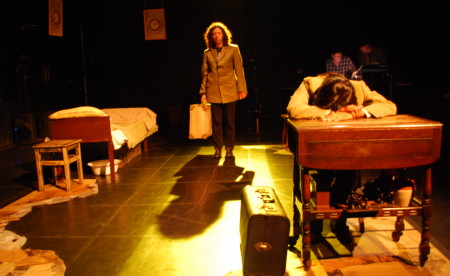
Passages began with the Director and I identifying the source material: the life, work and death-story of Walter Benjamin. We then established an overall way of working, and a structure and schedule for the process. An initial meeting of the company introduced the source material, and was followed by a two-week period for reflection and further research, as well as technical preparation of the studio space.
Fourteen days of rehearsals were spread over four and a half weeks, allowing company members time for various other commitments, as well as reflection and independent work on the project. As lighting artist, I was present in the rehearsal room throughout every rehearsal day with the custom-built Theolux control system and a lighting rig set up. Because we were rehearsing and performing in the same space, we did not have the conventional theatre distinction between ‘rehearsal’ (rehearsal in a rehearsal room without technical and scenographic apparatuses) and ‘production’ (rehearsal in the performance space with technical and scenographic apparatuses).
Thus we did not distinguish technical or dress rehearsals as such, but moved incrementally from relatively unstructured development of performance material to the rehearsal of an emergent performance script in increasingly structured and formalised ways. This structuring was shaped particularly by the Director, who organised the material into a series of sections that could be rehearsed as freestanding sequences.
Some sections foregrounded lighting or sound, and each section gradually acquired its own aesthetic and dramatic tone. As with the lighting, the scenic, costume and sonic elements were introduced, experimented with, developed and refined gradually throughout the rehearsal period, and with the involvement of all of the members of the company. The time between the rehearsal days allowed technical work in the studio space to be undertaken.
On the final day of rehearsals we ran the piece several times in a simulation of performance conditions, including one run with a small invited audience. On the performance day, we ran through the piece in the morning, with the performance for invited academics and professionals (selected for their ability to offer feedback from diverse perspectives through the post-performance discussion and individual correspondence) in the afternoon. An evening performance accommodated Rose Bruford College staff and students, as well as guests of the company, and gave an additional opportunity for feedback through a second post-performance discussion.
The black-box studio space used for the performance had no fixed seating arrangement or technical control area; it consists of a space approximately 13m x 9m, with a height of nearly 4m to the lighting grid. The set design emerged during the rehearsal period, beginning with some basic furniture for the hotel room: a bed, a small drop-leaf table (used also as a writing desk), two chairs and a stool.
Through the development and devising process, we decided that we wanted to introduce paper and writing in a variety of textures and qualities, together with a motif of clocks set to different times, intended to suggest travel and time-zones. By the end of the rehearsal process, various types of brown and tracing paper, printed with Benjamin’s characteristic handwriting and textures from old maps, were used on the floor in the corners of the stage space to help delineate the room boundaries, as well as providing the material for the construction of a large ‘map’ during the performance.
The clock motif appeared in the form of three framed pictures of clocks, each showing a different time and suspended where the rear and side walls of the hotel room would be. We made no attempt to hide the studio space beyond the hotel room, and indeed we retained as a scenic element all of the paperwork that had been generated during the rehearsals and placed on the studio walls.
The three actors were all dressed as Walter Benjamin, although the costumes were indicative rather than historically accurate, in accordance with our overall approach of being suggestive rather than realistic.

Photo by Francesca Camozzi